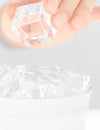Ice Melt and Dilution in Shaken Cocktails
While there are dozens of variables when making a traditional shaken cocktail, there are some rules of thumb regarding dilution that are highly resistant to changing these variables. In particular, regardless of the type of ingredients, the temperature of the ingredients, the type of ice, the duration of shaking, etc., the dilution rate is surprisingly constant. This can be a useful fact when designing recipes.
How Does Ice Chill a Liquid?
This might seem like a silly question. Ice chills a beverage because it's cold, right? Well, not really. Ice chills a beverage not by being cold, per se, but by melting. That's right--by melting. The process of melting ice—i.e., turning it from solid to liquid--takes an extraordinary amount of heat, and this heat comes from the liquid surrounding the ice. The ice “steals” heat from the surrounding liquid in order to melt, thus cooling the liquid. The amount of cooling you get from the actual "coldness" of the ice is much smaller, about a 160 times smaller.
You have probably heard that temperature is a measure of molecular motion. That is, when you heat something up, the molecules in that substance start moving faster. Temperature is simply a measure of the kinetic energy of the molecules.
When you get water cold enough, the molecules slow down enough that the attractive forces between the water molecules can finally overcome the kinetic energy of the molecules. When the kinetic energy is low enough, the water molecules latch onto each other and the water becomes a crystalline solid known as ice. This happens at 32 degrees Fahrenheit or 0 degrees Celsius.
Once the liquid water has "collapsed" into a solid, it is surprisingly hard to break the molecular bonds between the frozen water molecules and turn it back into a liquid. It takes 80 calories of heat energy to break all the bonds in one gram of ice and turn it into back into one gram of liquid water.
When you put ice in water, the ice melts because it absorbs heat from the water. The ice melts at the expense of heat from the water; so as the ice melts, the water cools For every gram of ice that melts, 80 calories of heat is removed from the surrounding water. This is known in physics as the heat of fusion of ice, 80 calories/gram.
Since the removal of one calorie from one gram of water will lower its temperature by one degree Celsius (by the definition of a calorie), melting just one gram of ice can chill a lot of water! In fact, melting one gram of ice in water could chill 80 grams of water by one degree, or 40 grams of water by two degrees, and so on.
Let’s go through the process in detail of what happens when you put ice in water. Now, you know that ice melts at 32 F, but be aware that Ice is usually well below 32 F—it will generally be at whatever temperature the freezer is set to (typically around 0 F)
When the ice and water are first mixed, the ice begins to chill the water a little bit simply due to the fact that the ice is colder than the water; likewise, the ice begins to warm up, simply because the water is warmer than the ice.
Now, when the ice warms all the way up to 32 F, it starts to melt—and that is where the real chilling power of ice comes in: every gram of ice that melts sucks 80 calories of heat from the surrounding liquid, rapidly bringing the temperature of the surrounding liquid down towards 32 F. Ice will continue to melt as long as the temperature of the surrounding water is above 32 F.
Eventually, assuming there is enough ice to begin with, the entire container of water will be at 32 F, and any remaining ice will also be at 32 F. The entire mixture of water and ice is now said to be in equilibrium, and there will be no further ice melt (at least not initially—over time, heat will be absorbed from the outside environment, which will lead to some further ice melt).
Even if you add more ice at this point, you will not get additional ice melt, because the mixture is already at 32 F. In fact, adding cold ice (i.e., ice well below 32 F) at this point would actually cause reverse dilution, freezing some of the liquid water into ice!
For our purposes of making shaken or stirred cocktails, and trying to calculate how much dilution we will get from the ice, we only need to determine how much ice is enough to get our cocktail mixture down to 32 F and how much extra dilution from ice melt will result from adding this ice, so we can adjust our recipes
accordingly.
Here are our rules of thumb for ice:
1) For every liter of liquid ingredients at room temperature, chilling it all the way to 32 F (0 C) will require about 300 g of ice, and thus result in 300 g of extra dilution. This works out to about 10 ounces of ice melt per quart of liquid ingredients.
2) Adding more than 300 g of ice per liter will not lead to any extra dilution, so err on the side of adding more ice than necessary.
In our next blog post, we will get quantitative and derive an equation to calculate the actual dilution rate in cocktails, and do a numerical example.




